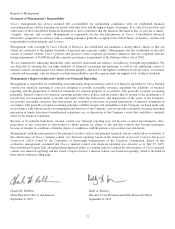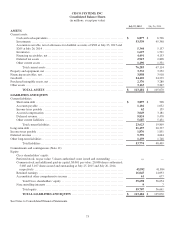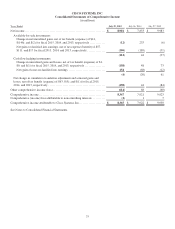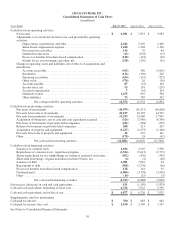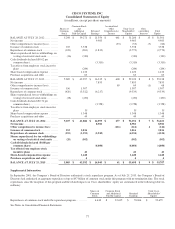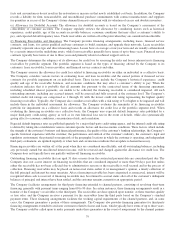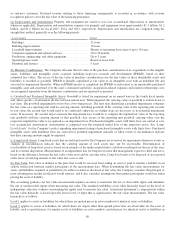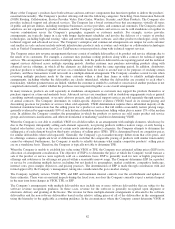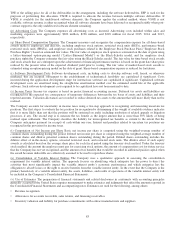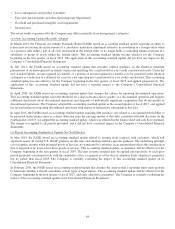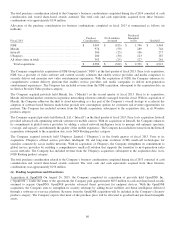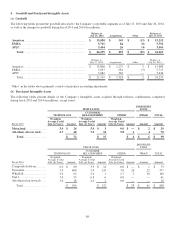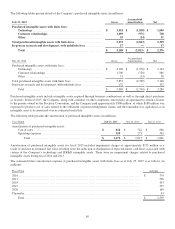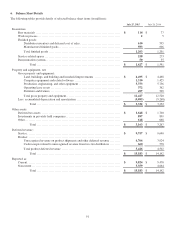Cisco 2015 Annual Report Download - page 89
Download and view the complete annual report
Please find page 89 of the 2015 Cisco annual report below. You can navigate through the pages in the report by either clicking on the pages listed below, or by using the keyword search tool below to find specific information within the annual report.
markets with insufficient volume or infrequent transactions (less active markets); or model-derived valuations in which
significant inputs are observable or can be derived principally from, or corroborated by, observable market data.
Level 3 applies to assets or liabilities for which there are unobservable inputs to the valuation methodology that are significant to
the measurement of the fair value of the assets or liabilities.
(l) Derivative Instruments The Company recognizes derivative instruments as either assets or liabilities and measures those
instruments at fair value. The accounting for changes in the fair value of a derivative depends on the intended use of the
derivative and the resulting designation. For a derivative instrument designated as a fair value hedge, the gain or loss is
recognized in earnings in the period of change together with the offsetting loss or gain on the hedged item attributed to the risk
being hedged. For a derivative instrument designated as a cash flow hedge, the effective portion of the derivative’s gain or loss is
initially reported as a component of AOCI and subsequently reclassified into earnings when the hedged exposure affects earnings.
The ineffective portion of the gain or loss is reported in earnings immediately. For a derivative instrument designated as a net
investment hedge of the Company’s foreign operations, the gain or loss is recorded in the cumulative translation adjustment
within AOCI together with the offsetting loss or gain of the hedged exposure of the underlying foreign operations. Any
ineffective portion of the net investment hedges is reported in earnings during the period of change. For derivative instruments
that are not designated as accounting hedges, changes in fair value are recognized in earnings in the period of change. The
Company records derivative instruments in the statements of cash flows to operating, investing, or financing activities consistent
with the cash flows of the hedged item.
Hedge effectiveness for foreign exchange forward contracts used as cash flow hedges is assessed by comparing the change in the
fair value of the hedge contract with the change in the fair value of the forecasted cash flows of the hedged item. Hedge
effectiveness for equity forward contracts and foreign exchange net investment hedge forward contracts is assessed by comparing
changes in fair value due to changes in spot rates for both the derivative and the hedged item. For foreign exchange option
contracts, hedge effectiveness is assessed based on the hedging instrument’s entire change in fair value. Hedge effectiveness for
interest rate swaps is assessed by comparing the change in fair value of the swap with the change in the fair value of the hedged
item due to changes in the benchmark interest rate.
(m) Foreign Currency Translation Assets and liabilities of non-U.S. subsidiaries that operate in a local currency environment,
where that local currency is the functional currency, are translated to U.S. dollars at exchange rates in effect at the balance sheet
date, with the resulting translation adjustments directly recorded to a separate component of AOCI. Income and expense accounts
are translated at average exchange rates during the year. Remeasurement adjustments are recorded in other income (loss), net.
The effect of foreign currency exchange rates on cash and cash equivalents was not material for any of the fiscal years presented.
(n) Concentrations of Risk Cash and cash equivalents are maintained with several financial institutions. Deposits held with banks
may exceed the amount of insurance provided on such deposits. Generally, these deposits may be redeemed upon demand and are
maintained with financial institutions with reputable credit and therefore bear minimal credit risk. The Company seeks to mitigate
its credit risks by spreading such risks across multiple counterparties and monitoring the risk profiles of these counterparties.
The Company performs ongoing credit evaluations of its customers and, with the exception of certain financing transactions, does
not require collateral from its customers. The Company receives certain of its components from sole suppliers. Additionally, the
Company relies on a limited number of contract manufacturers and suppliers to provide manufacturing services for its products.
The inability of a contract manufacturer or supplier to fulfill supply requirements of the Company could materially impact future
operating results.
(o) Revenue Recognition The Company recognizes revenue when persuasive evidence of an arrangement exists, delivery has
occurred, the fee is fixed or determinable, and collectibility is reasonably assured. In instances where final acceptance of the
product, system, or solution is specified by the customer, revenue is deferred until all acceptance criteria have been met. For
hosting arrangements, the Company recognizes subscription revenue ratably over the subscription period, while usage revenue is
recognized based on utilization. Software subscription revenue is deferred and recognized ratably over the subscription term upon
delivery of the first product and commencement of the term. Technical support services revenue is deferred and recognized
ratably over the period during which the services are to be performed, which is typically from one to three years. Advanced
services revenue is recognized upon delivery or completion of performance milestones.
The Company uses distributors that stock inventory and typically sell to systems integrators, service providers, and other
resellers. The Company refers to this as its two-tier system of sales to the end customer. Revenue from distributors is recognized
based on a sell-through method using information provided by them. Distributors and other partners participate in various rebate,
cooperative marketing, and other programs, and the Company maintains estimated accruals and allowances for these programs.
The ending liability for these programs was included in other current liabilities, and the balance as of each of July 25, 2015 and
July 26, 2014 was $1.3 billion. The Company accrues for warranty costs, sales returns, and other allowances based on its
historical experience. Shipping and handling fees billed to customers are included in revenue, with the associated costs included
in cost of sales.
81



